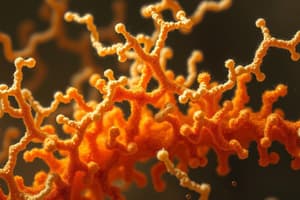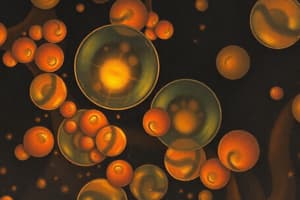Podcast
Questions and Answers
Which function is NOT associated with membrane proteins?
Which function is NOT associated with membrane proteins?
- Catalyze biochemical reactions
- Identify cell type
- Transport molecules across the membrane
- Synthesize DNA (correct)
Which component of the cytoskeleton primarily contributes to mechanical support?
Which component of the cytoskeleton primarily contributes to mechanical support?
- Cilia
- Microfilaments
- Microtubules
- Intermediate filaments (correct)
What characteristic distinguishes the rough endoplasmic reticulum from the smooth endoplasmic reticulum?
What characteristic distinguishes the rough endoplasmic reticulum from the smooth endoplasmic reticulum?
- Interaction with lysosomes
- Presence of ribosomes (correct)
- Location near the nucleus
- Function in lipid synthesis
What is the primary role of cilia in a cell?
What is the primary role of cilia in a cell?
What structure is primarily responsible for forming ribosomes?
What structure is primarily responsible for forming ribosomes?
Which feature is NOT a function of the plasma membrane?
Which feature is NOT a function of the plasma membrane?
What type of molecules primarily move freely across the plasma membrane?
What type of molecules primarily move freely across the plasma membrane?
What describes the 'fluid mosaic model' of the plasma membrane?
What describes the 'fluid mosaic model' of the plasma membrane?
Flashcards
Plasma Membrane
Plasma Membrane
The plasma membrane is a double layer of phospholipids and proteins that encloses the cell, regulating what enters and exits. It serves as a barrier and a control center for the cell.
Phospholipids
Phospholipids
Phospholipids are the building blocks of cell membranes. They have a hydrophilic (water-loving) head and a hydrophobic (water-fearing) tail.
Carrier Proteins
Carrier Proteins
Carrier proteins are specialized proteins embedded in the lipid bilayer of the plasma membrane. They bind to specific molecules and transport them across the membrane.
Fluid Mosaic Model
Fluid Mosaic Model
Signup and view all the flashcards
Cytoplasm
Cytoplasm
Signup and view all the flashcards
Cytoskeleton
Cytoskeleton
Signup and view all the flashcards
Cilia & Flagella
Cilia & Flagella
Signup and view all the flashcards
Centrioles
Centrioles
Signup and view all the flashcards
Study Notes
Cell Structure and Function
- A microscopic image shows numerous sperm cells.
Plasma Membrane
- Contains the cell's contents.
- Composed of a double layer of phospholipids and proteins.
- Phospholipids have a hydrophilic (water-loving) head and a hydrophobic (water-fearing) tail.
- The hydrophilic heads face outward, interacting with the watery environment.
- The hydrophobic tails face inward, forming a barrier.
- Cholesterol is present within the membrane, and proteins are embedded in the phospholipid bilayer.
- Glycolipids and glycoproteins extend from the membrane, helping with cell recognition.
Phospholipids
- Phospholipids are polar molecules.
- The head of a phospholipid molecule is hydrophilic (attracted to water).
- The tail of a phospholipid molecule is hydrophobic (repelled by water).
- Phospholipids are crucial components of the plasma membrane.
Movement Across the Plasma Membrane
- Some molecules (water, carbon dioxide, ammonia, oxygen) move freely across the membrane.
- Carrier proteins transport other molecules across the membrane.
- The fluid mosaic model describes the fluidity of the lipid bilayer.
Membrane Proteins
- Channels/transporters - Move molecules in one direction.
- Receptors - Recognize specific chemicals.
- Glycoproteins - Identify cell type.
- Enzymes - Catalyze substance production.
Cytoplasm
- Viscous fluid containing organelles and components of the cell.
- Contains interconnected filaments and fibers (cytoskeleton).
- Contains organelles and storage substances, excluding the nucleus.
Cytoskeleton
- Network of filaments and fibers within the cell.
- Composed of microfilaments, microtubules, and intermediate filaments.
- Provides mechanical support, anchors organelles, and helps move substances within the cell.
Cilia and Flagella
- Provide motility for cells.
- Cilia are short, hair-like structures used to move substances outside cells.
- Flagella are whip-like extensions, found on sperm cells.
- Both structure containing organized bundles of microtubules surrounded by plasma membrane.
Centrioles
- Pairs of microtubular structures.
- Play a role in cell division.
Membranous Organelles
- Functional components within the cytoplasm.
- Bound by membranes.
- Examples include; free ribosomes, mitochondria, Golgi apparatus, lysosomes, smooth endoplasmic reticulum, rough endoplasmic reticulum, microfilaments, plasma membrane, and cilia.
Nucleus
- Control center of the cell.
- Contains DNA organized into chromosomes.
- Contains the nucleolus, the site of ribosome production.
- Encased in a double membrane.
Nuclear Envelope
- Separates the nucleus from the rest of the cell.
- Composed of a double membrane.
- Contains pores that allow substances to pass between the nucleus and the cytoplasm.
DNA
- Hereditary material.
- Organized into chromosomes, which are composed of DNA and proteins.
- Chromosomes condense prior to cell division, forming chromatin, aiding cell division
Nucleolus
- Most cells have two or more nucleoli.
- Directs the synthesis of RNA.
- Responsible for the formation of ribosomes.
Endoplasmic Reticulum
- Network of interconnected membranes within the cell.
- Aids in moving substances within the cell.
- Two types: rough endoplasmic reticulum (RER) and smooth endoplasmic reticulum (SER).
Rough Endoplasmic Reticulum (RER)
- Ribosomes attached to its surface.
- Involved in protein manufacturing, particularly proteins that are destined for secretion.
- Can modify proteins from ribosomes.
Smooth Endoplasmic Reticulum (SER)
- Lacks ribosomes.
- Contains enzymes that synthesize carbohydrates and lipids.
Studying That Suits You
Use AI to generate personalized quizzes and flashcards to suit your learning preferences.
Related Documents
Description
Test your knowledge on cell biology with this quiz focused on membrane proteins, cytoskeletal components, and organelle functions. Explore key characteristics that distinguish various cell structures, including the differences between the rough and smooth endoplasmic reticulum. Perfect for students of cell biology and related fields.




